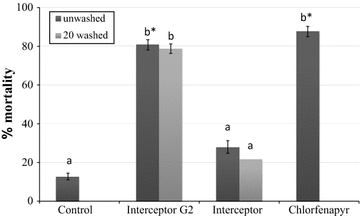Evaluation of efficacy of Interceptor® G2, a long-lasting insecticide net coated with a mixture of chlorfenapyr and alpha-cypermethrin, against pyrethroid resistant Anopheles gambiae s.l. in Burkina Faso
- PMID: 28482891
- PMCID: PMC5422893
- DOI: 10.1186/s12936-017-1846-4
Evaluation of efficacy of Interceptor® G2, a long-lasting insecticide net coated with a mixture of chlorfenapyr and alpha-cypermethrin, against pyrethroid resistant Anopheles gambiae s.l. in Burkina Faso
Abstract
Background: Malaria vectors have acquired widespread resistance throughout sub-Saharan Africa to many of the currently used insecticides. Hence, there is an urgent need to develop alternative strategies including the development of new insecticides for effective management of insecticide resistance. To maintain progress against malaria, it is necessary to identify other residual insecticides for mosquito nets. In the present WHOPES phase II analogue study, the utility of chlorfenapyr, a pyrrole class insecticide mixed with alpha-cypermethrin on a long-lasting mosquito bed net was evaluated against Anopheles gambiae s.l.
Methods: Bed nets treated with chlorfenapyr and alpha-cypermethrin and mixture of both compounds were tested for their efficacy on mosquitoes. Washed (20 times) and unwashed of each type of treated nets and were tested according to WHOPES guidelines. Efficacy of nets were expressed in terms of blood-feeding inhibition rate, deterrence, induced exophily and mortality rate. The evaluation was conducted in experimental huts of Vallée du Kou seven (VK7) in Burkina Faso (West Africa) following WHOPES phase II guidelines. In addition, a WHOPES phase I evaluation was also performed.
Results: Mixture treated nets killed significantly (P < 0.05) more mosquitoes than solo alpha-cypermethrin nets, unwashed and washed. Proportionally, this equated to mortalities of 78 and 76% (for mixture nets) compared to only 17 and 10% (for solo alpha-cypermethrin) to An. gambiae, respectively. In contrast mixture net proportions were not significantly (P > 0.05) different from nets treated with chlorfenapyr 200 mg/m2 unwashed (86%). The washed and unwashed nets treated with the mixtures resulted in personal protection against An. gambiae s.l. biting 34 and 44%. In contrast the personal protection observed for washed and unwashed alpha-cypermethrin treated nets generated (14 and 24%), and chlorfenapyr solo treated net was rather low (22%).
Conclusion: Among all nets trialled, the combination of chlorfenapyr and alpha-cypermethrin on bed nets provided better mortality in phase II after 20 washes. Results suggest that this combination could be a potential insecticide resistance management tool for preventing malaria transmission in areas compromised by the spread of pyrethroid resistance.
Keywords: Anopheles gambiae; Bed net; Chlorfenapyr; Insecticide; Malaria; Pyrethroid resistance.
Figures




Similar articles
-
Which intervention is better for malaria vector control: insecticide mixture long-lasting insecticidal nets or standard pyrethroid nets combined with indoor residual spraying?Malar J. 2017 Aug 16;16(1):340. doi: 10.1186/s12936-017-1987-5. Malar J. 2017. PMID: 28814307 Free PMC article.
-
Small-scale field evaluation of PermaNet® Dual (a long-lasting net coated with a mixture of chlorfenapyr and deltamethrin) against pyrethroid-resistant Anopheles gambiae mosquitoes from Tiassalé, Côte d'Ivoire.Malar J. 2023 Feb 1;22(1):36. doi: 10.1186/s12936-023-04455-z. Malar J. 2023. PMID: 36726160 Free PMC article.
-
Efficacy of interceptor® G2, a long-lasting insecticide mixture net treated with chlorfenapyr and alpha-cypermethrin against Anopheles funestus: experimental hut trials in north-eastern Tanzania.Malar J. 2021 Apr 9;20(1):180. doi: 10.1186/s12936-021-03716-z. Malar J. 2021. PMID: 33836778 Free PMC article. Clinical Trial.
-
Piperonyl butoxide (PBO) combined with pyrethroids in insecticide-treated nets to prevent malaria in Africa.Cochrane Database Syst Rev. 2018 Nov 29;11(11):CD012776. doi: 10.1002/14651858.CD012776.pub2. Cochrane Database Syst Rev. 2018. Update in: Cochrane Database Syst Rev. 2021 May 24;5:CD012776. doi: 10.1002/14651858.CD012776.pub3. PMID: 30488945 Free PMC article. Updated.
-
Piperonyl butoxide (PBO) combined with pyrethroids in insecticide-treated nets to prevent malaria in Africa.Cochrane Database Syst Rev. 2021 May 24;5(5):CD012776. doi: 10.1002/14651858.CD012776.pub3. Cochrane Database Syst Rev. 2021. PMID: 34027998 Free PMC article.
Cited by
-
Key Characteristics of Residual Malaria Transmission in Two Districts in South-Eastern Tanzania-Implications for Improved Control.J Infect Dis. 2021 Apr 27;223(12 Suppl 2):S143-S154. doi: 10.1093/infdis/jiaa653. J Infect Dis. 2021. PMID: 33906218 Free PMC article. Review.
-
Vector-Focused Approaches to Curb Malaria Transmission in the Brazilian Amazon: An Overview of Current and Future Challenges and Strategies.Trop Med Infect Dis. 2020 Oct 20;5(4):161. doi: 10.3390/tropicalmed5040161. Trop Med Infect Dis. 2020. PMID: 33092228 Free PMC article. Review.
-
Understanding the current state-of-the-art of long-lasting insecticide nets and potential for sustainable alternatives.Curr Res Parasitol Vector Borne Dis. 2022 Sep 19;2:100101. doi: 10.1016/j.crpvbd.2022.100101. eCollection 2022. Curr Res Parasitol Vector Borne Dis. 2022. PMID: 36248356 Free PMC article. Review.
-
Evaluation of an alpha-cypermethrin + PBO mixture long-lasting insecticidal net VEERALIN® LN against pyrethroid resistant Anopheles gambiae s.s.: an experimental hut trial in M'bé, central Côte d'Ivoire.Parasit Vectors. 2019 Nov 15;12(1):544. doi: 10.1186/s13071-019-3796-x. Parasit Vectors. 2019. PMID: 31730481 Free PMC article.
-
Differential impact of dual-active ingredient long-lasting insecticidal nets on primary malaria vectors: a secondary analysis of a 3-year, single-blind, cluster-randomised controlled trial in rural Tanzania.Lancet Planet Health. 2023 May;7(5):e370-e380. doi: 10.1016/S2542-5196(23)00048-7. Lancet Planet Health. 2023. PMID: 37164513 Free PMC article. Clinical Trial.
References
-
- Lengeler C. Insecticide-treated bed nets and curtains for preventing malaria. Cochrane Database Syst Rev. 2004;2:CD000363. - PubMed
-
- Natacha P, Alexandra W, Philippa AW, Robinson T, Franklin WM, William K, et al. Combination of insecticide treated nets and indoor residual spraying in Northern Tanzania provides additional reduction in vector population density and malaria transmission rates compared to insecticide treated nets alone: a randomised control trial. PLoS ONE. 2015;10:e0142671. doi: 10.1371/journal.pone.0142671. - DOI - PMC - PubMed
Publication types
MeSH terms
Substances
LinkOut - more resources
Full Text Sources
Other Literature Sources
Medical

